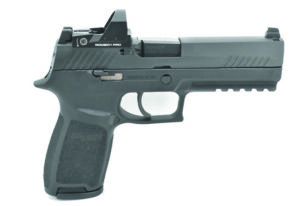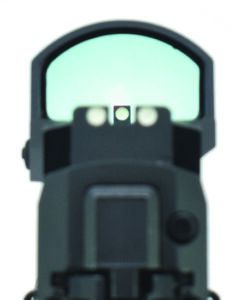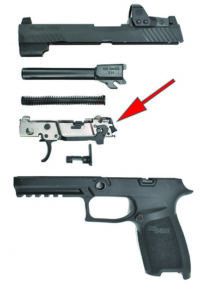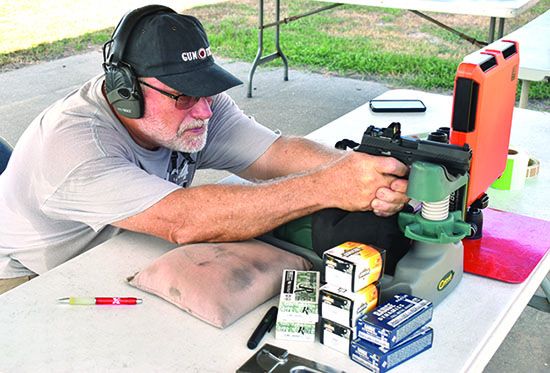Most of the law-enforcement officers on the street must face their challenges with nothing more than their training, experience, courage and the handguns on their hips. Those pistols have to go bang every time, and they have to hit what they are pointed at. Glock stills rules a large part of that world with their simplicity, ruggedness, and competitive price. The company has maintained that position by listening to its customers and by issuing successive generations of Glock Perfection, each bringing incremental improvements to the platform.
We grabbed one of the company’s latest versions, the Glock Model 47 PA475S204MOS, $629, which has most of the components set up to allow them to interchange with other similarly-sized Glocks. Our test piece has the slide cut for their Modular Optical System, or MOS.
Our second test item is the SIG Sauer P320 RX 320F-9-B-RXP, $880, which includes the Romeo 1 Pro sight. A strong contender for the LEO market, this pistol is very similar to the winner of the Army’s recent MHS (Modular Handgun System) competition, using the same serialized Fire Control Unit and many of the same parts. We grabbed one of the latest models with the full-length frame, a dust cover long enough to hang just about any light on, a slide already milled for optical sights, and backup sights in case the optics fail.
Our last entrant is the even newer Springfield Armory Echelon EC9459B-3D, $650. Utilizing a separate Central Operating Group, a la the SIG, the Echelon also brings interchangeable grip modules to the table. Add in a very robust optics mounting system. and we would get to see if the Echelon could keep up with the SIG P320 and the latest Glock Model 47 at the range.
Both the Glock 47 and the Springfield Armory Echelon were shot using a Trijicon RMR Reflex sight (RM01-C-700600, $478). The model of the SIG P320 we chose comes with a SIG Sauer Romeo 1 Pro, $358, already mounted. Here’s what we found:
SIG Sauer P320 RXP Full-Size P320F-9-B-RXP 9mm Luger
$880
Gun Tests grade: A (OUR PICK)
The SIG P320 RXP won both our accuracy tests and the speed drills — barely. We liked the Romeo 1 Pro that comes mounted on the pistol and the way the OEM dot-sight interface allows both Leupold Delta Point Pro and Trijicon RMR units.

| Action Type | Semi-auto, striker fired |
| Overall Length | 8.1 in. |
| Overall Height w/o optic | 5.7 in. |
| Overall Height w/optic | 6.25 in. |
| Maximum Width | 1.34 in. |
| Weight Unloaded | 1.6 lbs. |
| Weight Loaded | 2.3 lbs. |
| Slide Material | Stainless steel |
| Slide Retraction Effort | 15.9 lbs. |
| Receiver Material | Polymer |
| Finish | Nitron |
| Front Strap Height | 2.25 in. |
| Back Strap Height | 3.5 in. |
| Barrel Length | 4.7 in. |
| Grip Thickness (Maximum) | 1.34 in. |
| Grip Circumference | 5.5 in. |
| Magazines | (2) 17-round |
| Rear Sight | Two dot, drift adjustable |
| Front Sight | One dot, drift adjustable |
| Sight Radius | 6.4 in. |
| Trigger Pull Weight | 4.7 lbs. |
| Trigger Span | 2.8 in. |
| Safety | Firing pin block |
| Warranty | Limited lifetime |
| Telephone | (603) 610-3000 |
| Website | SIGSauer.com |
| Made In | U.S. |
Whether we are talking about the military, a local police department, or just people like us, budgets are a consideration in every purchase we make. One possible solution is to make a single piece of equipment mated to a few different parts fill multiple roles. Our Glock 47 in this article does that to a certain extent. The soon-to-be-discussed Echelon from Springfield Armory is also modular. The SIG Sauer P320 won the Modular Handgun System contest as designed by the U.S. Army. SIG’s concept was to create a separate Fire Control Unit (FCU) that could easily be transferred to various frames and then mated with different top ends.
Our sample SIG P320 RXP most closely mimics the company’s M17 model with its 4.7-inch barrel and full-length slide, though the military model also sports the optional thumb safety along with a slightly shorter dust cover. The military versions are all colored FDE, but ours is flat black. The muzzle is beveled to make it easier to insert into a holster. The upper flats on the slide are also angled in, giving a nice, sculpted look and saving a bit of weight. Grasping grooves are located fore and aft on the slide, and on our sample, suppressor-height sights are mounted in dovetails. That also serves to put the sights at a level that allows them to be viewed above the rear deck of the Romeo 1 Pro red-dot sight. We noted these sights are made of metal — good on SIG. They also sport a single white dot on the front and two white dots on the rear. We’ve stated before that we don’t like the dots on the rear sight, and we’re sticking to our guns on that.

We have commented about SIG Sauer optics mounts and their perceived limitations in the past. As we explored the mount on this pistol, we see that SIG may have stepped their game up a bit with the P320 RXP model. The latest optics cut comes with two sets of mounting holes that allow attachment of two very popular patterns. The Romeo 1 Pro conforms to the same pattern required by the Leupold Delta Point Pro, and a second set of holes allows the mounting of a Trijicon RMR or SRO sight. While that doesn’t make it a universal mount (something we have been screaming for), it does offer a mounting solution for a number of the major red-dot sights. The Romeo 1 Pro is also an improvement over their Romeo 1, with the new dot being brighter, the battery lasting longer, and a shroud that protects better.
SIG put all the magic and the pixie dust down inside the grip module. No longer a frame per se, the grip is a hollow shell designed to hold a proprietary Fire Control Unit. The FCU can easily be removed and transferred to a different module that can vary in color, size, and shape. Standalone FCUs are available from companies like Brownells for around $350. Wilson Combat and Bruce Gray, among others, offer different versions as well. Colors run the gamut from blue to FDE to black and sizes from small to large. With grip prices starting at just over $40, it is easy for you to customize your own P320. FCU removal requires that the pistol be field-stripped first — always check that it is empty, lock the slide to the rear, rotate the takedown latch to the vertical, press down the slide stop, and release the slide assembly forward. Then rotate the takedown latch and pull it out at the same time. Last, pry up the front of the FCU, then slide the FCU up and forward, removing it from the grip module. The trigger is now exposed and easy to change in case you like the flat-faced triggers so popular now. There is a trick to getting that trigger back together, and we strongly recommend you watch a video for that. With very little movement required and only 4.7 pounds of compression needed, we were pleased with our trigger and would leave it alone.

The dust cover on the module has a Picatinny rail with five slots, allowing lots of room for lights and lasers. Our P320 had the medium grip module, and it worked well for us. SIG provides a good grip texture that almost encircles the grip. We would like to see it a bit more aggressive, but then we like pistols that stick in our hands.
As with the Glock, the P320 is pretty left-hander friendly with its reversible mag release and an ambidextrous slide stop. The takedown latch was left side only, but the FCU design requires a single-side latch, and they went with 80% + of the population. The magazine well was easy to hit as we worked reloads, but it was not flared or beveled. We would love to see that addressed.
Our Team Said: Feeding and function were perfect over several hundred rounds fired. In our subjective opinion, the SIG P320 was the softest shooting of the three guns in this test. We liked the way the sight tracked in rapid fire and settled down quickly for the next shot. The P320 won both the speed and accuracy tests — again, barely. All three pistols did extremely well, the P320 just a hair better. Combined average accuracy for five-shot groups at 15 yards was 1.17 inches. The SIG showed a preference for the Fiocchi 147-grain fodder, posting a 0.92 inch average there.
| 9MM LUGER RANGE DATA | |||
| Remington 115-grain FMJ | Glock Model 47 | SIG Sauer P320 | Springfield Armory Echelon |
| Average Velocity | 1142 fps | 1149 fps | 1157 fps |
| Muzzle Energy | 333 ft.-lbs. | 337 ft.-lbs. | 342 ft.-lbs. |
| Best Group Size | 1.44 in. | 1.19 in. | 1.23 in. |
| Average Group Size | 1.75 in. | 1.43 in. | 1.42 in. |
| Armscor 124-grain JHP | Glock Model 47 | SIG Sauer P320 | Springfield Armory Echelon |
| Average Velocity | 1127 fps | 1164 fps | 1162 fps |
| Muzzle Energy | 350 ft.-lbs. | 373 ft.-lbs. | 372 ft.-lbs. |
| Best Group Size | 1.03 in. | 0.69 in. | 1.16 in. |
| Average Group Size | 1.17 in. | 1.17 in. | 2.06 in. |
| Fiocchi 147-grain FMJ | Glock Model 47 | SIG Sauer P320 | Springfield Armory Echelon |
| Average Velocity | 952 fps | 960 fps | 978 fps |
| Muzzle Energy | 296 ft.-lbs. | 301 ft.-lbs. | 312 ft.-lbs. |
| Best Group Size | 1.03 in. | 0.82 in. | 0.90 in. |
| Average Group Size | 1.27 in. | 0.92 in. | 1.24 in. |
How we tested: We conducted our tests at American Shooting Centers in Houston. At 15 yards, we fired multiple five-shot groups for accuracy by shooting from a well-sandbagged Caldwell Pistolero shooting rest (MidwayUSA.com 517357, $28) assisted by a Mini DRC Fortune Cookie from Wiebad.com ($75, #MINIFC). We also wanted to test practical accuracy, so we did two additional tests. The first used 3-by-5-inch stickies attached to paper targets 8 yards downrange. We recorded first-shot times using 115-grain ammo. Then we shot controlled pairs (two sights with two sight pictures) also at 8 yards and using the same 3-by-5-inch targets. The third was a single shot on an A Zone plate (5-by-11 inches) at 32 yards. Start position on all drills was from the low ready. We used a LabRadar (MyLabRadar.com, $559) to obtain velocities using three different types of ammunition. The first was Remington Range 115-grain full-metal-jacket rounds. Then we tried Armscor 124-grain FMJs and some heavier-weight bullets using the Fiocchi Range Dynamics 147-grain FMJs.
| DRILL NO. 1 DATA | |
| Pistol | Single Shot Average Time |
| Glock Model 47 | 0.93 |
| SIG Sauer P320 | 0.82 |
| Springfield Echelon | 0.89 |
Process: Fire one shot from low ready at 3-by-5-inch card placed at 15 yards. Numbers are averages for eight repetitions. Times are in seconds.
| DRILL NO. 2 DATA | |||
| Pistol | 1st Shot | Split Average | Total Time |
| Glock Model 47 | 1.01 | 0.21 | 1.22 |
| SIG Sauer P320 | 0.92 | 0.178 | 1.098 |
| Springfield Echelon | 0.86 | 0.183 | 1.043 |
Process: Fire two shots from low ready at 3-by-5-inch card placed at 8 yards. Numbers are averages for four repetitions. Times are in seconds.
| DRILL NO. 3 DATA | |
| Pistol | Single Shot Average Time |
| Glock Model 47 | 1.27 |
| SIG Sauer P320 | 1.12 |
| Springfield Echelon | 1.26 |
Process: Fire one shot from low ready at 5-by-11-inch A-Zone target placed at 32 yards. Numbers are averages for four repetitions. Times are in seconds.
Written and photographed by Joe Woolley, using evaluations from Gun Tests Team members. GT

























